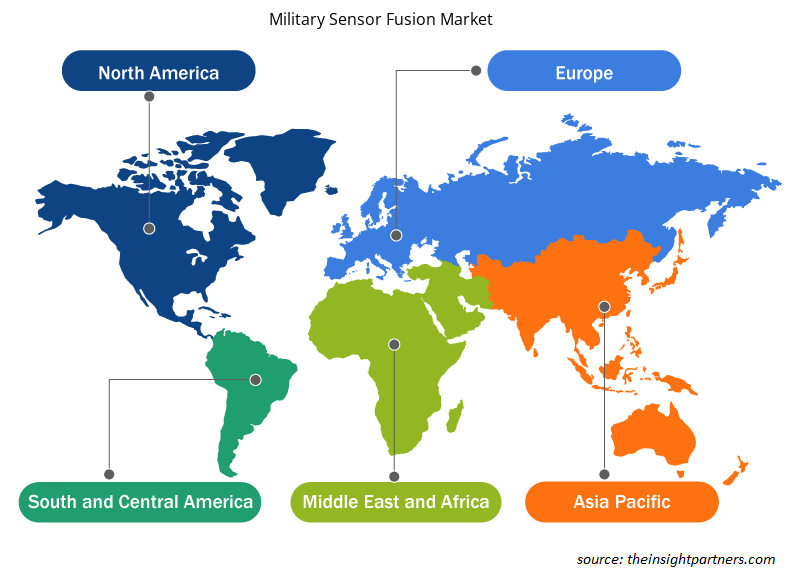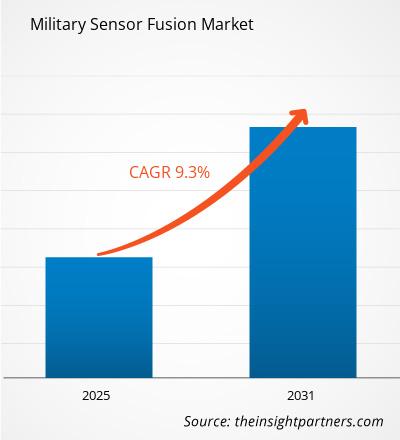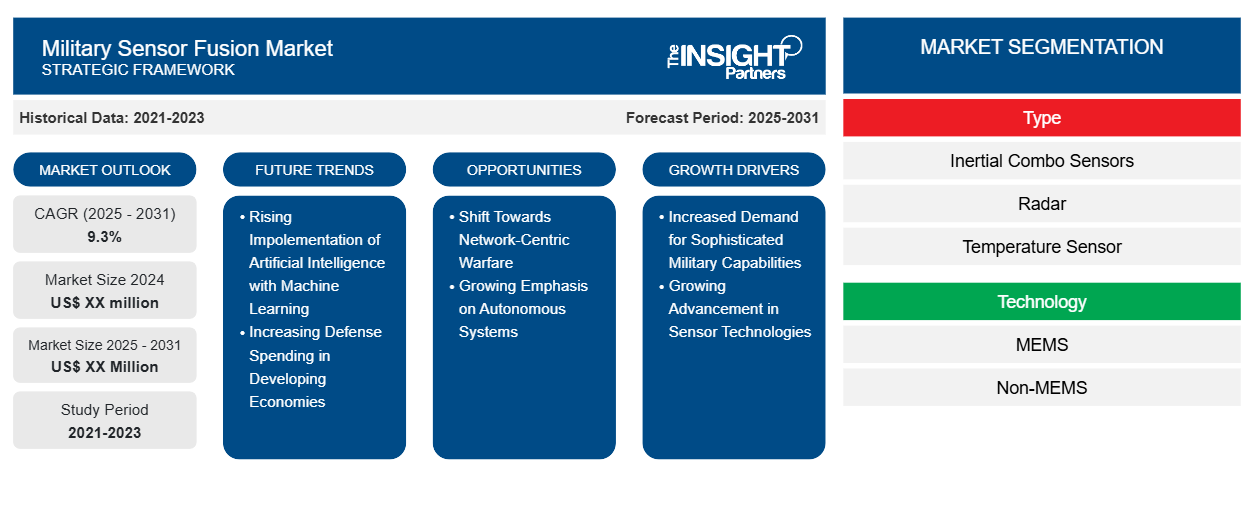من المتوقع أن يسجل سوق دمج أجهزة الاستشعار العسكرية معدل نمو سنوي مركب بنسبة 9.3٪ من عام 2023 إلى عام 2031، مع توسع حجم السوق من XX مليون دولار أمريكي في عام 2023 إلى XX مليون دولار أمريكي بحلول عام 2031.
تم تقسيم التقرير حسب النوع (أجهزة استشعار كومبو بالقصور الذاتي، الرادار، جهاز استشعار درجة الحرارة، نظام تحديد المواقع العالمي، أجهزة أخرى). كما يقدم التقرير تحليلاً يعتمد على التكنولوجيا (أجهزة MEMS، أجهزة غير MEMS). كما يقدم التقرير تحليلاً يعتمد على المنصة (محمولة جواً، برية، بحرية). كما يقدم التقرير تحليلاً يعتمد على التطبيق (القيادة والتحكم، ISR، التعرف على الهدف، الملاحة، الوعي الظرفي، أجهزة أخرى). تم تقسيم التحليل العالمي بشكل أكبر على المستوى الإقليمي والدول الرئيسية. يقدم التقرير القيمة بالدولار الأمريكي للتحليل والأجزاء المذكورة أعلاه.الأنظمة الكهروميكانيكية الصغرى ، الأنظمة غير الكهروميكانيكية الصغرى ). يقدم التقرير تحليلاً آخر يعتمد على المنصة (المحمولة جواً، والبرية، والبحرية). ويقدم التقرير تحليلاً آخر يعتمد على التطبيق (القيادة والتحكم، والاستطلاع والمراقبة والاستطلاع ، والتعرف على الهدف، والملاحة، والوعي بالموقف، وغير ذلك). وينقسم التحليل العالمي إلى مستويات إقليمية ودول رئيسية. ويقدم التقرير القيمة بالدولار الأمريكي للتحليل والقطاعات المذكورة أعلاه.
غرض التقرير
يهدف تقرير سوق دمج أجهزة الاستشعار العسكرية الصادر عن The Insight Partners إلى وصف المشهد الحالي والنمو المستقبلي وأهم العوامل الدافعة والتحديات والفرص. وسيوفر هذا رؤى لمختلف أصحاب المصلحة في الأعمال التجارية، مثل:
- مزودي/مصنعي التكنولوجيا: لفهم ديناميكيات السوق المتطورة ومعرفة فرص النمو المحتملة، وتمكينهم من اتخاذ قرارات استراتيجية مستنيرة.
- المستثمرون: إجراء تحليل شامل للاتجاهات فيما يتعلق بمعدل نمو السوق، وتوقعات السوق المالية، والفرص المتاحة عبر سلسلة القيمة.
- الهيئات التنظيمية: لتنظيم السياسات ومراقبة الأنشطة في السوق بهدف تقليل الانتهاكات والحفاظ على ثقة المستثمرين ودعم سلامة السوق واستقرارها.
تجزئة سوق دمج أجهزة الاستشعار العسكرية
يكتب
- أجهزة استشعار القصور الذاتي المركبة
- رادار
- مستشعر درجة الحرارة
- نظام تحديد المواقع العالمي (جي بي اس)
- آحرون
تكنولوجيا
- MEMS
- غير MEMS
منصة
- محمول جوا
- مبني على الأرض
- بحري
طلب
- القيادة والتحكم
- الاستخبارات والمراقبة والتقييم
- التعرف على الهدف
- ملاحة
- الوعي الظرفي
- آحرون
طلب
- القيادة والتحكم
- الاستخبارات والمراقبة والتقييم
- التعرف على الهدف
- ملاحة
- الوعي الظرفي
- آحرون
قم بتخصيص هذا التقرير ليناسب متطلباتك
ستحصل على تخصيص لأي تقرير - مجانًا - بما في ذلك أجزاء من هذا التقرير، أو تحليل على مستوى الدولة، وحزمة بيانات Excel، بالإضافة إلى الاستفادة من العروض والخصومات الرائعة للشركات الناشئة والجامعات
- احصل على أهم اتجاهات السوق الرئيسية لهذا التقرير.ستتضمن هذه العينة المجانية تحليلاً للبيانات، بدءًا من اتجاهات السوق وحتى التقديرات والتوقعات.
عوامل نمو سوق دمج أجهزة الاستشعار العسكرية
- الطلب المتزايد على القدرات العسكرية المتطورة: إن الزيادة في الطلب على الوعي الظرفي المعزز يدفع سوق دمج أجهزة الاستشعار العسكرية. يمكن للقوات العسكرية تحقيق معرفة شاملة بساحة المعركة من خلال دمج البيانات من مجموعة متنوعة من أجهزة الاستشعار، وبالتالي تحسين عملية اتخاذ القرار وتعزيز الفعالية التشغيلية. يشهد السوق نموًا بسبب الطلب المتزايد على القدرات العسكرية المتقدمة. حاليًا، تعمل الصناعة العسكرية بشكل متزايد على تعزيز الفعالية التشغيلية بناءً على التقنيات المتقدمة. يمكن لدمج أجهزة الاستشعار دمج البيانات من العديد من أجهزة الاستشعار المختلفة، مما يوفر وعيًا ظرفيًا نهائيًا وهو أمر حيوي للغاية عند اتخاذ القرارات في بيئة أكثر تعقيدًا. هذا الطلب على تحسينات القدرات هو سبب للنمو في سوق دمج أجهزة الاستشعار العسكرية.
- التقدم المتزايد في تقنيات الاستشعار: إن التقدم في تقنيات الاستشعار بالإضافة إلى التطورات ذات الصلة في معالجة البيانات والتحليلات هي القوة الدافعة لسوق دمج أجهزة الاستشعار العسكرية. تؤدي هذه القدرة إلى اكتساب أفضل وأسرع لتمثيل المعلومات، وهو أمر بالغ الأهمية للمفاهيم التشغيلية للجيوش حاليًا. إن التقدم في تقنيات الاستشعار سريع للغاية من حيث التحسينات في الدقة والتصغير والفعالية من حيث التكلفة، مما يدفع سوق دمج أجهزة الاستشعار العسكرية. إن تطوير أنواع جديدة من أجهزة الاستشعار، بما في ذلك الليدار والرادار والأشعة تحت الحمراء، ودمجها في الأنظمة العسكرية من شأنه أن يعزز القدرة على جمع ومعالجة البيانات من مصادر متعددة في نفس الوقت.
الاتجاهات المستقبلية لسوق دمج أجهزة الاستشعار العسكرية
- التنفيذ المتزايد للذكاء الاصطناعي مع التعلم الآلي: يمكن لدمج المستشعرات الآن دمج الذكاء الاصطناعي والتعلم الآلي بطريقة مثيرة للاهتمام. ستوفر هذه التقنيات القدرة على تحليل البيانات الناتجة عن المستشعرات بشكل كامل بما يتجاوز مجرد التفسير، وأتمتة عمليات صنع القرار، وبالتالي المساعدة في تحسين كفاءة العمليات العسكرية. يمكن لخوارزميات الذكاء الاصطناعي معالجة كميات هائلة من بيانات المستشعرات بكفاءة أكبر، وبالتالي الاستجابة بشكل أسرع وأكثر دقة للعمليات العسكرية. من المرجح أن يجذب هذا التآزر الاستثمارات والابتكارات في هذا القطاع.
- زيادة الإنفاق الدفاعي في الاقتصادات النامية: هناك مجال كبير لنمو سوق دمج أجهزة الاستشعار العسكرية مع زيادة الإنفاق الدفاعي. يشهد قطاع الدفاع في الواقع نموًا واسع النطاق في الاقتصادات النامية التي تتطلع إلى تعزيز قوة جيشها مع الاستثمار في التقنيات المتطورة. بدأت الأسواق الناشئة في الاستثمار بشكل أكبر في قدراتها الدفاعية، مما يخلق فرصًا جديدة لتقنيات دمج أجهزة الاستشعار العسكرية. بالإضافة إلى ذلك، يمكن أن تؤدي التعاونات والشراكات الدولية في مشاريع الدفاع إلى زيادة الطلب على حلول دمج أجهزة الاستشعار، حيث تعمل البلدان معًا لتعزيز قدراتها العسكرية.
فرص سوق دمج أجهزة الاستشعار العسكرية
- التحول نحو الحرب القائمة على الشبكات: يتجه الاتجاه بسرعة نحو الحرب القائمة على الشبكات، حيث تعتمد العمليات العسكرية بشكل كبير على الأنظمة المتصلة وتبادل المعلومات في الوقت الفعلي. ويثير هذا التحول الحاجة إلى حلول دمج أجهزة الاستشعار المتقدمة التي يمكنها دمج المعلومات من العديد من المنصات وتحسين العمليات التعاونية. وتركز الاستراتيجيات العسكرية الآن بشكل أكبر على العمليات متعددة المجالات. وتتطلب مثل هذه العمليات دمج البيانات من المجالات البرية والجوية والبحرية والفضائية والسيبرانية. وبالتالي فإن تقنيات دمج أجهزة الاستشعار ضرورية لعملية التكامل. وبالتالي تتجه المنظمات العسكرية نحو الحلول التي يمكن أن تعمل عبر مجالات متعددة.
- التركيز المتزايد على الأنظمة المستقلة: يواصل الجيش إيلاء اهتمام وثيق للأنظمة المستقلة مع التركيز على دمج أجهزة الاستشعار من أجل الملاحة والفعالية التشغيلية كما هو الحال في الطائرات بدون طيار والمركبات غير المأهولة. سيضمن هذا أيضًا زيادة الطلب على تقنيات دمج أجهزة الاستشعار المحسنة التي يمكن أن تدعم هذه المنصات المستقلة. هناك اتجاه نحو تطوير أنظمة دمج أجهزة الاستشعار المعيارية والقابلة للتطوير والتي يمكن دمجها بسهولة في المنصات العسكرية الحالية. تسمح هذه المرونة بترقيات وتكييفات أسرع مع التقنيات الجديدة، مما يسهل على القوات العسكرية الحفاظ على التفوق التكنولوجي. وبالتالي، من المتوقع أن تؤدي الزيادة في استثمارات الجيوش في التقنيات المستقلة إلى تعزيز الطلب على حلول دمج أجهزة الاستشعار المتطورة.
رؤى إقليمية حول سوق دمج أجهزة الاستشعار العسكرية
لقد قام المحللون في Insight Partners بشرح الاتجاهات والعوامل الإقليمية المؤثرة على سوق دمج أجهزة الاستشعار العسكرية طوال فترة التوقعات بشكل شامل. يناقش هذا القسم أيضًا قطاعات سوق دمج أجهزة الاستشعار العسكرية والجغرافيا في جميع أنحاء أمريكا الشمالية وأوروبا ومنطقة آسيا والمحيط الهادئ والشرق الأوسط وأفريقيا وأمريكا الجنوبية والوسطى.

- احصل على البيانات الإقليمية المحددة لسوق دمج أجهزة الاستشعار العسكرية
نطاق تقرير سوق دمج أجهزة الاستشعار العسكرية
| سمة التقرير | تفاصيل |
|---|---|
| حجم السوق في عام 2023 | XX مليون دولار أمريكي |
| حجم السوق بحلول عام 2031 | XX مليون دولار أمريكي |
| معدل النمو السنوي المركب العالمي (2023 - 2031) | 9.3% |
| البيانات التاريخية | 2021-2022 |
| فترة التنبؤ | 2024-2031 |
| القطاعات المغطاة | حسب النوع
|
| المناطق والدول المغطاة | أمريكا الشمالية
|
| قادة السوق وملفات تعريف الشركات الرئيسية |
|
كثافة اللاعبين في سوق دمج أجهزة الاستشعار العسكرية: فهم تأثيرها على ديناميكيات الأعمال
يشهد سوق دمج أجهزة الاستشعار العسكرية نموًا سريعًا، مدفوعًا بالطلب المتزايد من المستخدم النهائي بسبب عوامل مثل تفضيلات المستهلكين المتطورة والتقدم التكنولوجي والوعي الأكبر بفوائد المنتج. ومع ارتفاع الطلب، تعمل الشركات على توسيع عروضها والابتكار لتلبية احتياجات المستهلكين والاستفادة من الاتجاهات الناشئة، مما يؤدي إلى زيادة نمو السوق.
تشير كثافة اللاعبين في السوق إلى توزيع الشركات أو المؤسسات العاملة في سوق أو صناعة معينة. وهي تشير إلى عدد المنافسين (اللاعبين في السوق) الموجودين في مساحة سوق معينة نسبة إلى حجمها أو قيمتها السوقية الإجمالية.
الشركات الرئيسية العاملة في سوق دمج أجهزة الاستشعار العسكرية هي:
- شركة ايشيلون للتكنولوجيا، ذ.م.م.
- الأجهزة التناظرية
- شركة بي أيه إي سيستمز
- شركة كيرتس رايت
- شركة إيسترلاين للتكنولوجيا
إخلاء المسؤولية : الشركات المذكورة أعلاه ليست مرتبة بأي ترتيب معين.

- احصل على نظرة عامة على أهم اللاعبين الرئيسيين في سوق دمج أجهزة الاستشعار العسكرية
نقاط البيع الرئيسية
- التغطية الشاملة: يغطي التقرير بشكل شامل تحليل المنتجات والخدمات والأنواع والمستخدمين النهائيين لسوق اندماج أجهزة الاستشعار العسكرية، مما يوفر صورة شاملة.
- تحليل الخبراء: تم تجميع التقرير على أساس الفهم العميق لخبراء الصناعة والمحللين.
- معلومات محدثة: يضمن التقرير أهمية الأعمال التجارية بسبب تغطيته للمعلومات الحديثة واتجاهات البيانات.
- خيارات التخصيص: يمكن تخصيص هذا التقرير لتلبية متطلبات العملاء المحددة وبما يتناسب مع استراتيجيات العمل بشكل مناسب.
وبالتالي، يمكن أن يساعد تقرير البحث حول سوق دمج أجهزة الاستشعار العسكرية في تمهيد الطريق لفك شفرة وفهم سيناريو الصناعة وآفاق النمو. ورغم وجود بعض المخاوف المشروعة، فإن الفوائد الإجمالية لهذا التقرير تميل إلى التفوق على العيوب.
- التحليل التاريخي (سنتان)، سنة الأساس، التوقعات (7 سنوات) مع معدل النمو السنوي المركب
- تحليل PEST و SWOT
- حجم السوق والقيمة / الحجم - عالمي، إقليمي، بلد
- الصناعة والمنافسة
- مجموعة بيانات إكسل
التقارير الحديثة
تقارير ذات صلة
شهادات العملاء
سبب الشراء
- اتخاذ قرارات مدروسة
- فهم ديناميكيات السوق
- تحليل المنافسة
- رؤى العملاء
- توقعات السوق
- تخفيف المخاطر
- التخطيط الاستراتيجي
- مبررات الاستثمار
- تحديد الأسواق الناشئة
- تحسين استراتيجيات التسويق
- تعزيز الكفاءة التشغيلية
- مواكبة التوجهات التنظيمية





















 احصل على عينة مجانية ل - سوق دمج أجهزة الاستشعار العسكرية
احصل على عينة مجانية ل - سوق دمج أجهزة الاستشعار العسكرية